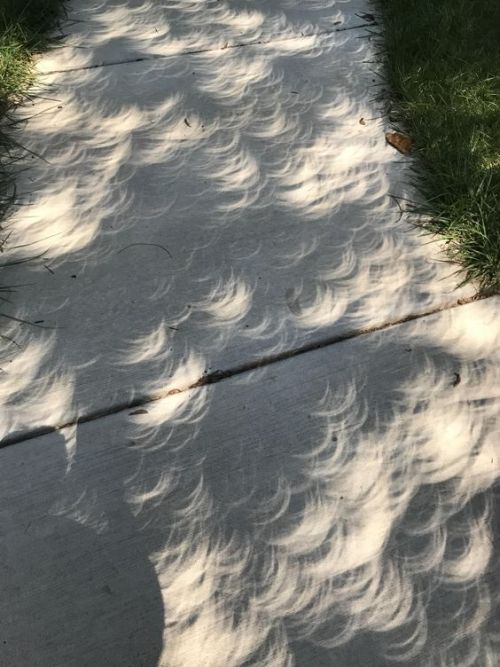Solar Eclipse Shadows








Solar eclipse shadows
More Posts from Cedezsstuff and Others

Astronomers have discovered the slowest spinning radio wave-blasting neutron star ever seen; it takes almost an hour to complete a full rotation. That may sound rather fast, but these dead stars are known to spin so rapidly that some experience 700 full turns every second. Even the most leisurely of the about 3,000 radio-emitting neutron stars, or "pulsars," discovered so far complete a full rotation in a second or so. This ultra-leisurely neutron star, however, designated ASKAP J1935+2148 and located 16,000 light-years from Earth, is emitting radio light at a rate too slow to even fit with current theories describing the behavior of these dense stellar remnants.
Continue Reading.










Total Solar Eclipse l April 2024 l U.S. & Canada
Cr. Deran Hall l Rami Ammoun(236) l GabeWasylko l REUTERS l KendallRust l Joshua Intini l Alfredo Juárez l KuzcoKhanda

Using the James Webb Space Telescope, University of Copenhagen researchers have become the first to see the formation of three of the earliest galaxies in the universe, more than 13 billion years ago. The sensational discovery contributes important knowledge about the universe and is now published in Science. For the first time in the history of astronomy, researchers at the Niels Bohr Institute have witnessed the birth of three of the universe's absolute earliest galaxies, somewhere between 13.3 and 13.4 billion years ago.
Continue Reading.

Engineer Karen Leadlay in a General Dynamics computer lab, 1964.




The Pleiades

Chris Birch
After an academic career at U.C. Riverside and Caltech, Chris Birch became a track cyclist on the U.S. National Team. She was training for the 2020 Olympics when she was chosen as an astronaut candidate. https://go.nasa.gov/49WJKHj
Make sure to follow us on Tumblr for your regular dose of space!

Dr. Mae Jemison was the first African American woman to travel in space. Born on October 17, 1956, in Decatur, Alabama, and raised in Chicago, Illinois, Jemison’s journey into the stars is a testament to the power of dreams and determination. 🚀


Hey, so--we cooled your boyfriend down to a hundredth of a kelvin above absolute zero. Yeah, it was so cold that all of the chemical reactions in his body ceased. Sorry. We, uh, yeah, we used him as a dielectric material in a tiny qubit. And then we quantum-entangled him with another qubit, just to see if we could. Sorry. Yeah, anyway, we thawed him out after two weeks and apparently he's doing fine now. Didn't really teach us anything about how quantum processes work in biological systems, but it sure was, uh, cool. If you'll pardon the pun.

Storm cloud over Texas l Laura Rowe NASA APOD

Flaps perform essential jobs. From pumping hearts to revving engines, flaps help fluid flow in one direction. Without them, keeping liquids going in the right direction is challenging to do. Researchers from the University of Washington have discovered a new way to help liquid flow in only one direction -- but without flaps. In a paper published Sept. 24 in the Proceedings of the National Academy of Sciences, they report that a flexible pipe -- with an interior helical structure inspired by shark intestines -- can keep fluid flowing in one direction without the flaps that engines and anatomy rely upon. Human intestines are essentially a hollow tube. But for sharks and rays, their intestines feature a network of spirals surrounding an interior passageway. In a 2021 publication, a different team proposed that this unique structure promoted one-way flow of fluids -- also known as flow asymmetry -- through the digestive tracts of sharks and rays without flaps or other aids to prevent backup. That claim caught the attention of UW postdoctoral researcher Ido Levin, lead author on the new paper.
Read more.
-
 intraclustermedium liked this · 1 month ago
intraclustermedium liked this · 1 month ago -
 luhdembbw reblogged this · 1 month ago
luhdembbw reblogged this · 1 month ago -
 sami-guinea-arts reblogged this · 1 month ago
sami-guinea-arts reblogged this · 1 month ago -
 thekinginjello liked this · 1 month ago
thekinginjello liked this · 1 month ago -
 closetedangel liked this · 1 month ago
closetedangel liked this · 1 month ago -
 moonfairs liked this · 1 month ago
moonfairs liked this · 1 month ago -
 nahbruhroad liked this · 1 month ago
nahbruhroad liked this · 1 month ago -
 angelsbrl liked this · 1 month ago
angelsbrl liked this · 1 month ago -
 therealmakachu liked this · 1 month ago
therealmakachu liked this · 1 month ago -
 isopodcemetery liked this · 2 months ago
isopodcemetery liked this · 2 months ago -
 losinend liked this · 2 months ago
losinend liked this · 2 months ago -
 thequeenwanderer reblogged this · 2 months ago
thequeenwanderer reblogged this · 2 months ago -
 detonade liked this · 2 months ago
detonade liked this · 2 months ago -
 sl33py-dy liked this · 2 months ago
sl33py-dy liked this · 2 months ago -
 blossom-vibez reblogged this · 2 months ago
blossom-vibez reblogged this · 2 months ago -
 nebularious reblogged this · 2 months ago
nebularious reblogged this · 2 months ago -
 nebularious liked this · 2 months ago
nebularious liked this · 2 months ago -
 blossom-vibez liked this · 2 months ago
blossom-vibez liked this · 2 months ago -
 will-e03 liked this · 2 months ago
will-e03 liked this · 2 months ago -
 silverhorse123 reblogged this · 2 months ago
silverhorse123 reblogged this · 2 months ago -
 fractalsausage reblogged this · 2 months ago
fractalsausage reblogged this · 2 months ago -
 100gecs liked this · 2 months ago
100gecs liked this · 2 months ago -
 catsandwildlife reblogged this · 2 months ago
catsandwildlife reblogged this · 2 months ago -
 lrgoescrazy liked this · 2 months ago
lrgoescrazy liked this · 2 months ago -
 bunnicula-7 liked this · 2 months ago
bunnicula-7 liked this · 2 months ago -
 lotualin liked this · 2 months ago
lotualin liked this · 2 months ago -
 samgardner1998 liked this · 2 months ago
samgardner1998 liked this · 2 months ago -
 abunnynamedbambi liked this · 2 months ago
abunnynamedbambi liked this · 2 months ago -
 rippleintheocean liked this · 2 months ago
rippleintheocean liked this · 2 months ago -
 meiheooo liked this · 2 months ago
meiheooo liked this · 2 months ago -
 mypastelelephant liked this · 2 months ago
mypastelelephant liked this · 2 months ago -
 channelrat reblogged this · 2 months ago
channelrat reblogged this · 2 months ago -
 sunriseswithyou-blog liked this · 2 months ago
sunriseswithyou-blog liked this · 2 months ago -
 ma-seule-exception reblogged this · 2 months ago
ma-seule-exception reblogged this · 2 months ago -
 secvndcitysaint liked this · 2 months ago
secvndcitysaint liked this · 2 months ago -
 stupendouslyavidreader liked this · 2 months ago
stupendouslyavidreader liked this · 2 months ago -
 hallaig reblogged this · 2 months ago
hallaig reblogged this · 2 months ago -
 mil-vueltas-al-sol reblogged this · 2 months ago
mil-vueltas-al-sol reblogged this · 2 months ago -
 man0dem0na liked this · 2 months ago
man0dem0na liked this · 2 months ago -
 corinnana liked this · 2 months ago
corinnana liked this · 2 months ago -
 chickennuggetsislikmyfamily liked this · 2 months ago
chickennuggetsislikmyfamily liked this · 2 months ago -
 stratusstormcloud liked this · 2 months ago
stratusstormcloud liked this · 2 months ago -
 sig-got-a-gun liked this · 2 months ago
sig-got-a-gun liked this · 2 months ago -
 arsonstick reblogged this · 2 months ago
arsonstick reblogged this · 2 months ago -
 sosa5054 liked this · 2 months ago
sosa5054 liked this · 2 months ago
